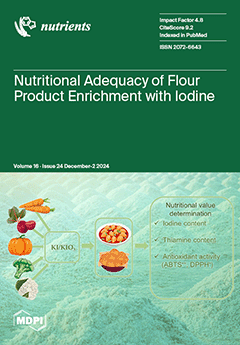Background: Anabolic resistance accelerates muscle loss in aging and obesity, thus predisposing to sarcopenic obesity. Methods: In this retrospective analysis of a randomized clinical trial, we examined baseline predictors of the adaptive response to three months of home-based resistance exercise, daily physical activity, and protein-based, multi-ingredient supplementation (MIS) in a cohort of free-living, older males (
n = 32). Results: Multiple linear regression analyses revealed that obesity and a Global Risk Index for metabolic syndrome (MetS) were the strongest predictors of Δ% gains in lean mass (TLM and ASM), LM/body fat ratios (TLM/%BF, ASM/FM, and ASM/%BF), and allometric LM (ASMI, TLM/BW, TLM/BMI, ASM/BW), with moderately strong, negative correlations to the adaptive response to polytherapy r = −0.36 to −0.68 (
p < 0.05). Kidney function, PA level, and chronological age were only weakly associated with treatment outcomes (
p > 0.05). Next, we performed a subgroup analysis in overweight/obese participants with at least one other MetS risk factor and examined their adaptive response to polytherapy with two types of protein-based MIS (PLA; collagen peptides and safflower oil,
n = 8, M5; whey/casein, creatine, calcium, vitamin D
3, and fish oil,
n = 12). The M5 group showed greater improvements in LM (ASM; +2% vs. −0.8%), LM/body fat ratios (ASM/FM; +3.8% vs. −5.1%), allometric LM (ASM/BMI; +1.2% vs. −2.5%), strength (leg press; +17% vs. −1.4%), and performance (4-Step-Stair-Climb time; −10.5% vs. +1.1%) vs. the PLA group (
p < 0.05). Bone turnover markers, indicative of bone accretion, were increased pre-to-post intervention in the M5 group only (P1NP;
p = 0.036, P1NP/CTX ratio;
p = 0.088). The overall anabolic response, as indicated by ranking low-to-high responders for Δ% LM (
p = 0.0079), strength (
p = 0.097), and performance (
p = 0.19), was therefore significantly higher in the M5 vs. PLA group (
p = 0.013). Conclusions: Our findings confirm that obesity/MetS is a key driver of anabolic resistance in old age and that a high-quality, whey/casein-based MIS is more effective than a collagen-based alternative for maintaining musculoskeletal health in individuals at risk for sarcopenic obesity, even when total daily protein intake exceeds current treatment guidelines.
Full article






